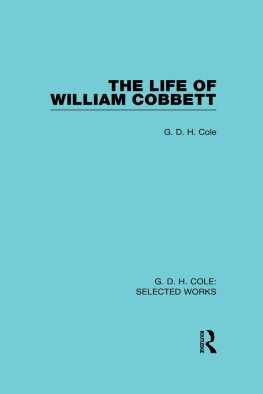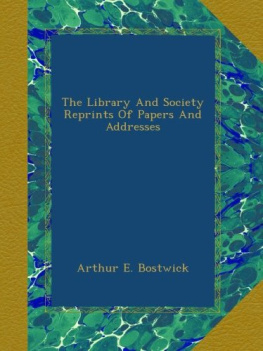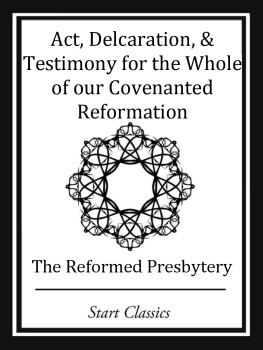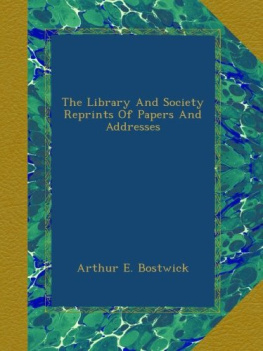A Monograph on glycerin and its uses
by Henry Hartshorne
Copyright 2017 by HardPress
Address:
HardPress
8345 NW 66TH ST #2561
MIAMI FL 33166-2626
USA
Email: info@hardpress.net
PREFACE.
The only treatises upon Glycerin with whose existence I am acquainted, those of M. Demarquay and of Dr. William Abbotts Smith, are almost unknown in this country. Most of the facts concerning it are scattered about in various journals; especially in those connected with Pharmacy.
I hope it may prove a not unserviceable task, to the advantage both of physicians and pharmacists, to collate anew these facts; and, without exaggerating anything, to show that in glycerin we have an article with a very wide range of uses, not yet all well determined. Much of the indifference which both druggists and practitioners have displayed toward it may be explained by disappointment resulting from the use of an imperfectly purified article. But, since the means of testing it are now understood to be very simple, it may be hoped that, in the future, its remarkable powers as a solvent, and advantages as a vehicle, as well as other available properties, may become better known and appreciated.
While claiming the credit only of a compiler in this little brochure, I have, at the same time, taken pains to verify the statements given, as far as was possible; and a few suggestions are made in regard to applications of glycerin, to which I venture to ask the attention of practitioners.
For aid in confirming, correcting and extending the accounts of authors in regard to the solvent powers of glycerin, I am especially indebted to Thomas S. Wiegand, chemist, of this city.
H. H.
V
ON GLYCERIN.
History.
Glycerin was discovered by

about 9, in the residuum from the manufacture of lead plaster. It was investigated more fully in 1811, by Cheerful and

by the former of whom its present name was given. Gay-Lussac and Cheerful patented a process for separating the fatty acids in 1825; but glycerin was hardly known in commerce in its pure state until the beautiful discovery and invention of Mr. Richard Albert Tillman, of Philadelphia, patented in 1854; by which it was found to be obtainable absolutely pure by a very simple process.
It was first introduced into medical use by T. De La Roche, in 1844; and, at his suggestion, by Mr. J. Star tin, in the London Hospital for Diseases of the Skin. Mr. Waring ton patented, in 1846,' a method for preserving meat in it; and also pointed out its value in preparing and preserving objects for the microscope.
Gerhard gives this date. An account is given of the discovery in the Tran sac. of the Royal Academy of Sweden for 1783.
Vide London Pharmaceutic. Journal, Nov. 1855.
Ibid.
Cap and Ga rot investigated it anew, and published their observations in 1854. By them and by M. Surun its solvent powers were principally determined. Many other chemists, pharmacists, and medical men have since given attention to its properties and relations; although, in the language of G. Fergus son Wilson, "not a tithe of its uses have yet been developed."
Occurrence in Nature.
Glycerin does not exist uncombined in nature. It is present in the fat of all animals, including man, in natural

or compounds with fatty acids. It is, therefore, evolved in the

by alkalies or basic oxides, of all oily and fatty substances.

and wax, however, contain none of it. Gobley found it in the yolk of eggs and in the human brain, in the condition of phospho-glyceric acid, or phosphate of glycerin. Bert helot asserts its existence in cod-liver oil, as triacetin, or tractate of glycerin. Pasteur states that it is always evolved, in small quantity, in ordinary vinous or alcoholic fermentation. It was formed artificially by Wurtz through a somewhat complicated process; treating the bromide of ally l with acetate of silver; thus obtaining

tractate of glycerin), which was

by

Jo urn. de P harm. et de Chime, April, Aug., and Oct., 1854. * Vide W. A. Smith, M.D., on Glycerine, p. 23.

Rend us, T. 21, pp. 766-769, et 988-992.
Miller's Organic Chemistry, vol. iii. p. 269.

Rend us, May, 1858.
"N
Properties. ,
Glycerin is a colorless syrupy liquid, decidedly sweet to the taste, in odorous when-pure, even when rubbed upon the hand. The specific gravity of the anhydrous is 1 -28 ;* of the best commercial preparation, having but two per cent. of water, 1-26. At 35 C-, it remains unfrozen.' Heated to a red heat it burns with a luminous blue flame. At 527 Fahd. it boils. When distilled without water it is decomposed, giving off acrolein,



























 about 9, in the residuum from the manufacture of lead plaster. It was investigated more fully in 1811, by Cheerful and
about 9, in the residuum from the manufacture of lead plaster. It was investigated more fully in 1811, by Cheerful and  by the former of whom its present name was given. Gay-Lussac and Cheerful patented a process for separating the fatty acids in 1825; but glycerin was hardly known in commerce in its pure state until the beautiful discovery and invention of Mr. Richard Albert Tillman, of Philadelphia, patented in 1854; by which it was found to be obtainable absolutely pure by a very simple process.
by the former of whom its present name was given. Gay-Lussac and Cheerful patented a process for separating the fatty acids in 1825; but glycerin was hardly known in commerce in its pure state until the beautiful discovery and invention of Mr. Richard Albert Tillman, of Philadelphia, patented in 1854; by which it was found to be obtainable absolutely pure by a very simple process. or compounds with fatty acids. It is, therefore, evolved in the
or compounds with fatty acids. It is, therefore, evolved in the  by alkalies or basic oxides, of all oily and fatty substances.
by alkalies or basic oxides, of all oily and fatty substances.  and wax, however, contain none of it. Gobley found it in the yolk of eggs and in the human brain, in the condition of phospho-glyceric acid, or phosphate of glycerin. Bert helot asserts its existence in cod-liver oil, as triacetin, or tractate of glycerin. Pasteur states that it is always evolved, in small quantity, in ordinary vinous or alcoholic fermentation. It was formed artificially by Wurtz through a somewhat complicated process; treating the bromide of ally l with acetate of silver; thus obtaining
and wax, however, contain none of it. Gobley found it in the yolk of eggs and in the human brain, in the condition of phospho-glyceric acid, or phosphate of glycerin. Bert helot asserts its existence in cod-liver oil, as triacetin, or tractate of glycerin. Pasteur states that it is always evolved, in small quantity, in ordinary vinous or alcoholic fermentation. It was formed artificially by Wurtz through a somewhat complicated process; treating the bromide of ally l with acetate of silver; thus obtaining  tractate of glycerin), which was
tractate of glycerin), which was  by
by 
 Rend us, T. 21, pp. 766-769, et 988-992.
Rend us, T. 21, pp. 766-769, et 988-992.